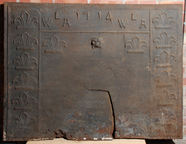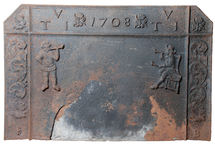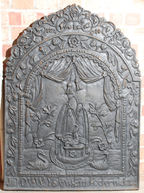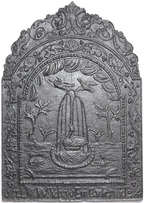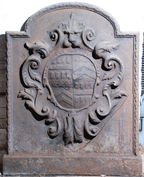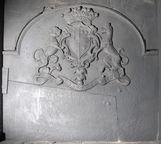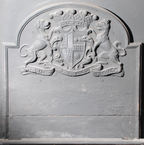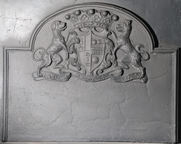-
223
Description: Rectangular; cavetto with double fillet edging; two side panels each separated by twisted rope, and each containing six fleurs de lys arranged vertically; top panel separated by twisted rope, containing inscription; central panel with lion’s head between two fleurs de lys.
Notes: A late example of the use of individual carved stamps; from Heol Ddu Isaf, Bargoed, acquired by the National Museum of Wales in 1922.
Inscription: WLA [triad] 1714 WLA [triad]
- Decoration tags:
- rectangular (shape)
- carved stamps
- individual letters
- individual numbers
- heraldic
- text
Manufactured: in 1714 possibly in the South Wales area of Wales.
Current location: National History Museum, St Fagans, Glamorgan, Wales.
Museum number: 21.31 (part of the Welsh National History Museum museum group)
- Attached to series:
- Miscellaneous stamp firebacks
- Date & initials firebacks
-
225
Description: Canted rectangle; cavetto moulded edging (top and sides); single horizontal fillet below canted corners and vertical fillet parallel to each side, dividing the fireback into two side panels, two top corner panels, top panel and main central panel; corner panels, ‘daisy’ plant stamp; top panel, date between ‘daisy’ stamps, between initials in triad at each end; side panels, swirling foliage stamp repeated each side above initials, I to left, B to right; centre panel, stamp of ‘Indian’ smoking a pipe at top left, stamp of seated ‘gentleman’ smoking a pipe and holding another, at top right.
Notes: The 'daisy' stamp and the IB initials are identical to those on similar firebacks dated between 1703 and 1721, and probably indicating the same founder. The use of stamps relating to tobacco smoking may suggest an origin near Bristol, the main entry port for the tobacco trade at that time. Formerly at Lilly Hall, Ledbury, Herefordshire.
Inscription: TVI [triad] 1708 TVI [triad] / I B
- Decoration tags:
- rectangular with canted top corners (shape)
- cavetto (edging)
- carved stamps
- individual letters
- individual numbers
- text
- humans
- plants
Manufactured: in 1708 in the Forest of Dean area of England.
Current location: National History Museum, St Fagans, Glamorgan, Wales.
Museum number: 13.90/2 (part of the Welsh National History Museum museum group)
- Attached to series:
- IB series
- Date & initials firebacks
-
226
Description: Arched rectangular shaped central panel with bead-and-pellet edging on a wide fillet; central pedestal with a wyvern fountain ringed with water, and a swan and a duck swimming, plants rising from the waves; above, swags of drapery with two central tassels; arched rectangular shaped border with fillet edging, symmetrical floral fronds descending from a rose, top centre, with a looped 'W' in each shoulder; inscription at base, between date; on top, symmetrical scrolled plant tendrils. A single vertical plankline right of centre.
Notes: One of a group of firebacks all of the same date, some of which have the same Welsh inscription which translates as 'God is our strength'. All incorporate the looped 'W' motif which may be intended to identify the pattern maker. The design is taken from 'Livres de Fontaines' by Daniel Marot (1661-1752) (La Haye & Amsterdam 1701). The swan and the duck swimming may have been copied from etchings or paintings by Francis Barlow (c.1624-1709), whose images of birds have been used incidentally on other firebacks. Formerly at Allt-y-ferin, Nantgaredig, Carmarthenshire.
Copies of this fireback are known.
Inscription: 17 DVW Ydyw Ein Cadernid 24
- Decoration tags:
- 'Dutch' (shape)
- fillet (edging)
- whole carved pattern
- planklines
- pictorial
- architectural
- text
- animals
- plants
- objects
Manufactured: in 1724 in England.
Current location: National History Museum, St Fagans, Glamorgan, Wales.
Museum number: 62.156 (part of the Welsh National History Museum museum group)
- Attached to series:
- 1724 series
- Welsh inscription series
- British 'Dutch' style firebacks
-
238
Description: Arched rectangular shaped central panel with bead-and-pellet edging on a wide fillet; crowned figure, holding a sceptre in his right hand, sitting in a chariot drawn to the left by two, caparisoned horses with ostrich feather head-dresses; the whole upon a three-arched bridge with keystones and a string course, waves beneath; above, swagged drapery with two tassels hanging from the centre; arched rectangular shaped border with fillet edging, symmetrical, descending oak leaf and acorn branches, with a looped 'W' in each shoulder; inscription at base; on top, symmetrical scrolled plant tendrils and berries. A single central vertical plankline.
Notes: One of a series produced in the same year. All incorporate the looped 'W' motif which may be intended to identify the pattern maker. The design is derived from a personification of Europe, one of a set of playing cards entitled Jeu de la Géographie, designed by Stefano della Bella for Louis XIV. The inscription translates as 'God is our strength'.
Copies of this fireback are known.
Inscription: 17 DVW Ydyw Ein Cadernid 24
- Decoration tags:
- 'Dutch' (shape)
- fillet (edging)
- whole carved pattern
- planklines
- pictorial
- allegorical
- text
- animals
- humans
- objects
Manufactured: in 1724 in England.
Current location: Tredegar House, Pencarn Way, Duffryn, Newport, Gwent, Wales.
Museum number: F81.233 (part of the Welsh National History Museum museum group)
- Attached to series:
- 1724 series
- Welsh inscription series
- British 'Dutch' style firebacks
-
240
Description: Arched rectangular shaped central panel with bead-and-pellet edging on a wide fillet; ground with birds, and trees behind; in the centre a circular fountain rim with a swan on a plinth surrounded by water, with jets of water rising from the swan’s mouth and descending on either side; above, a heron and a goose fly to the left; under the arch, swags of drapery; arched rectangular shaped border with fillet edging, symmetrical floral fronds descending from a scallop shell, top centre, with a looed 'W' in each shoulder; inscription at base between date; on top, symmetrical scrolled plant tendrils. A single central vertical plankline.
Notes: One of a group of firebacks, all of the same date, some of which have the same Welsh inscription which translates as 'God is our strength'. All incorporate the looped 'W' motif which may be intended to identify the pattern maker. The design is adapted from an illustration of fountain no. XXXIX, 'Les Cannes et le Petit Barbet' in Labyrinthe de Versailles by Sébastien le Clerc (1677); the flying heron and duck are copied from illustrations by Francis Barlow (c1626-1704) or from engravings of his work by Wenceslaus Hollar (1607-77).
Copies of this fireback are known.
Inscription: 17 DVW Ydyw Ein Cadernid 24
- Decoration tags:
- 'Dutch' (shape)
- fillet (edging)
- whole carved pattern
- planklines
- pictorial
- architectural
- text
- animals
- objects
Manufactured: in 1724 in England.
Current location: Newton House, Dinefwr, Llandeilo, Carmarthenshire, Wales.
Museum number: F83.116 (part of the Welsh National History Museum museum group)
Citation: Lloyd, N., 1925, 'Domestic Ironwork I', Architectural Review, 58, pp. 58-67.
- Attached to series:
- 1724 series
- Welsh inscription series
- British 'Dutch' style firebacks
-
1282
Description: Rectangular shape; wide fillet and ogee-moulded edging; approximately top centre, initials RH, with date 1701 centred below.
Notes: The character set for the initials and date lacks uniformity, some carved crudely, others more carefully; the lettering differs from another fireback (see no. 1166), with the same initials and date, by the position and shape of the letter 'R'. Formerly at Nethercote, Netherfield Hill, East Sussex. The former location in the Netherfield area of these two firebacks suggests a possible association with Richard Hay, owner of land in that area at that time and ironmaster at Beech Furnace nearby.
Inscription: R H / 1701
- Decoration tags:
- rectangular (shape)
- fillet and ogee (edging)
- carved stamps
- individual letters
- individual numbers
- text
Manufactured: in 1701 possibly at Beech Furnace, Battle in the Weald area of England.
Current location: in private hands, Catsfield, East Sussex, England.
- Attached to series:
- Date & initials firebacks
-
34
Description: Arched rectangular shape; astragal and fillet edging (top and sides) with overlapping leaf pattern; floral cartouche with lion’s face at top, enclosing a shield bearing the arms of May (Gules, a fess between eight billets Or) quartering Broadnax (Or, two chevrons gules, on a chief of the last three cinquefoils Argent); at base a plain cuboid plinth.
Notes: Thomas Broadnax (1701-81), son of William Broadnax of Godmersham, Kent, and Anne May, heiress of Christopher May, inherited the estate of his cousin, Sir Thomas May, adopting his surname in 1727. He later changed his name to Knight on inheriting the estate of that family at Chawton in 1738.
Arms: May quartering Broadnax
- Decoration tags:
- rectangular with round arch (shape)
- astragal & fillet (edging)
- carved pattern panels
- armorial
Manufactured: in the early-18th century possibly in the Weald area of England.
Current location: Chawton House, Chawton, Hampshire, England.
- Attached to series:
- Personal armorial firebacks
-
248
Description: Arched rectangular shape; astragal and fillet edging; shield, motto, earl’s coronet and supporters (a talbot erm. and a wolf or, ducally crowned gu.) of Stanhope impaling Pitt: quarterly (1st & 4th) erm. (2nd & 3rd) gu. (Stanhope); sa., a fess chequy az. and ar. between three bezants (Pitt); motto: A DEO ET REGE.
Notes: James Stanhope was created 1st Earl in 1718; he had married Lucy Pitt in 1714. The Stanhope seat was Chevening, near Sevenoaks.
Inscription: A DEO ET REGE
Arms: Stanhope impaling Pitt; James, Ist Earl Stanhope
- Decoration tags:
- rectangular with round arch (shape)
- astragal & fillet (edging)
- carved pattern panels
- armorial
- text
Manufactured: in the early-18th century in England.
Current location: Chevening Park, Chevening, Kent, England.
- Attached to series:
- Personal armorial firebacks
- Stanhope series
-
249
Description: Arched rectangular shape; astragal and fillet edging; shield, motto, earl’s coronet and supporters (a talbot erm. and a wolf or, ducally crowned gu.) of Stanhope impaling Pitt: quarterly (1st & 4th) erm. (2nd & 3rd) gu. (Stanhope); sa., a fess chequy az. and ar. between three bezants (Pitt); motto: A DEO ET REGE.
Notes: James Stanhope was created 1st Earl in 1718; he had married Lucy Pitt in 1714. The Stanhope seat was Chevening, near Sevenoaks.
Inscription: A DEO ET REGE
Arms: Stanhope impaling Pitt; James, 1st Earl Stanhope
- Decoration tags:
- rectangular with round arch (shape)
- astragal & fillet (edging)
- carved pattern panels
- armorial
Manufactured: in the early-18th century in England.
Current location: Chevening Park, Chevening, Kent, England.
- Attached to series:
- Personal armorial firebacks
- Stanhope series
-
250
Description: Arched rectangular shape; astragal and fillet edging; shield, motto, earl’s coronet and supporters (a talbot erm. and a wolf or, ducally crowned gu.) of Stanhope impaling Pitt: quarterly (1st & 4th) erm. (2nd & 3rd) gu. (Stanhope); sa., a fess chequy az. and ar. between three bezants (Pitt); motto: A DEO ET REGE.
Notes: James Stanhope was created 1st Earl in 1718; he had married Lucy Pitt in 1714. The Stanhope seat was Chevening, near Sevenoaks.
Inscription: A DEO ET REGE
Arms: Stanhope impaling Pitt; James, 1st Earl Stanhope
- Decoration tags:
- rectangular with round arch (shape)
- astragal & fillet (edging)
- carved pattern panels
- armorial
- text
Manufactured: in the early-18th century in England.
Current location: Chevening Park, Chevening, Kent, England.
- Attached to series:
- Personal armorial firebacks
- Stanhope series
